
Privacy statement: Your privacy is very important to Us. Our company promises not to disclose your personal information to any external company with out your explicit permission.
![]() January 13, 2021
January 13, 2021
1. The overall composition of pure Electric Vehicles
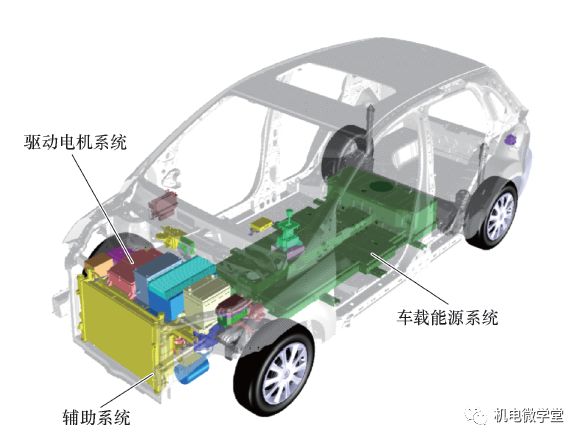
☝The structure of pure electric vehicles
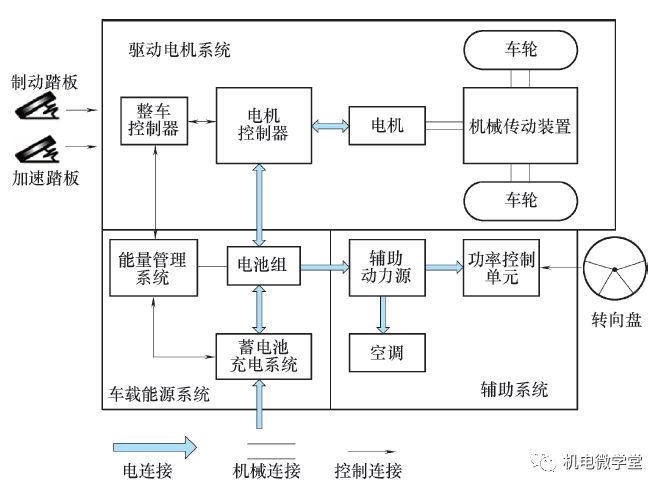
Composition block diagram

2. Power battery system

☝The composition of power battery


☝Lithium-ion battery structure

☝Power battery pack

☝Battery management system (BMS) block diagram


☝BMS structure

☝Master control box and slave control box

☝High voltage box and sensor
Three, drive motor system

DC motors and three-phase asynchronous motors


Permanent magnet synchronous motors and switched reluctance motors
[Video] AC asynchronous motor structure and principle

☝Wheel motor


☝Motor Controller (MCU)

☝MCU communication function

☝MCU port
Four, charging system
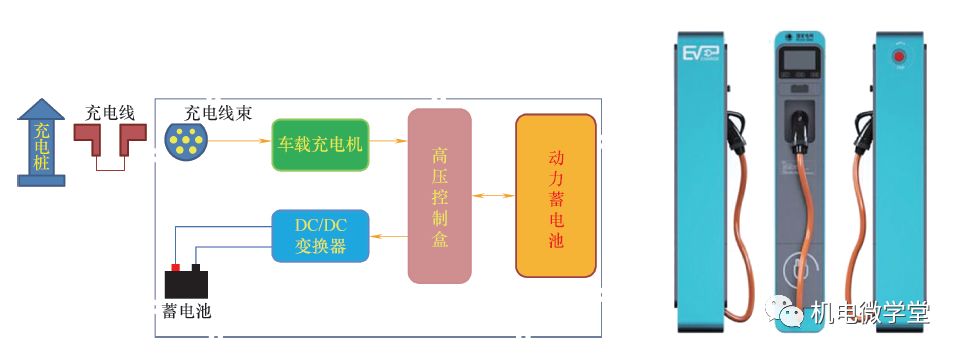
☝Slow charging system

☝Slow charging port pin definition

☝DC fast charging and vehicle fast charging port

☝Fast charging port pin definition


☝Car charger


☝DC/DC converter wiring port

☝High voltage control box and its internal structure


☝High voltage electrical system
5. Braking system

☝The structure of vacuum assisted braking

☝Electric vacuum pump

☝The working principle of the electric brake system
6. Air conditioning system
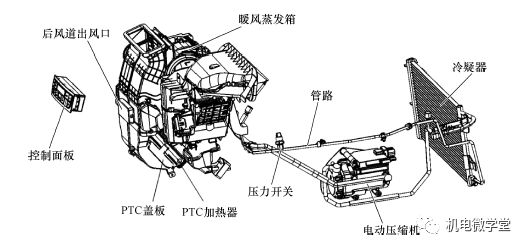
☝Air conditioning system structure

☝Electric scroll compressor

☝PTC heater
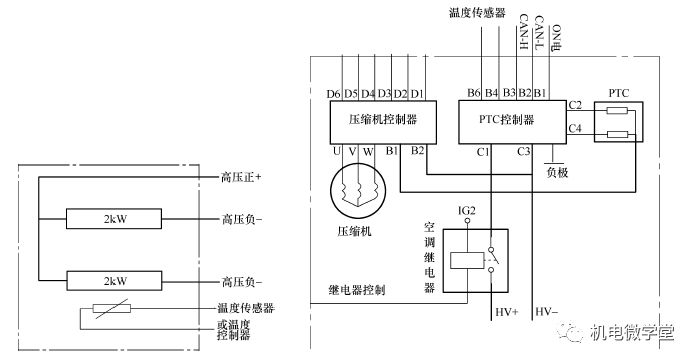
PTC heater structure and control principle
The basic structure and core technology of pure electric vehicles revealed
Title: Pure electric vehicles are vehicles that are powered entirely by rechargeable batteries (such as lead-acid batteries, nickel-cadmium batteries, nickel-hydrogen batteries or lithium-ion batteries).
1. What is a pure electric vehicle
Pure electric vehicles are vehicles that are powered entirely by rechargeable batteries (such as lead-acid batteries, nickel-cadmium batteries, nickel-hydrogen batteries or lithium-ion batteries).
The advantages of pure electric vehicles are: no pollution, low noise; simple structure, easy to use and maintain; high energy conversion efficiency; at the same time, it can recover energy during braking and downhill, improving energy utilization efficiency; it can use the power grid at night. "Valley power" for charging, plays a role in smoothing the peak and valley difference of the power grid.
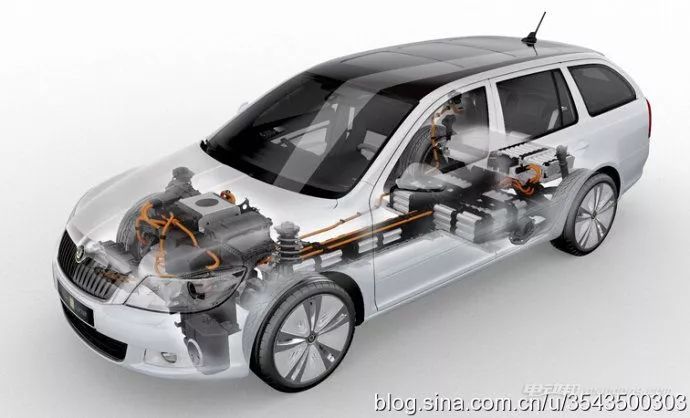
2. What are the basic structures of pure electric vehicles?
Electric vehicles have a variety of structural arrangements and are relatively flexible. In summary, they are divided into two forms: pure electric vehicle motor central drive and electric wheel drive. The central driving form of the electric motor borrows the driving scheme of the internal combustion engine vehicle, replacing the internal combustion engine with an electric motor and related components, and using an electric motor to drive the wheels on the left and right sides. The volume and mass of the mechanical transmission device in the form of electric wheel drive are greatly reduced compared with the central drive form of the electric motor, and the efficiency is significantly improved, at the expense of increasing the complexity and cost of the control system.
3. What types of pure electric vehicles are there?
Since the development of pure electric vehicles, there are many types, usually classified according to the purpose of the vehicle, the number of on-board power supplies, and the composition of the drive system. According to different purposes, pure electric vehicles can be divided into three types: electric cars, electric Trucks and electric buses.
(1) Electric cars are currently the most common Pure Electric Cars. In addition to some concept cars, mass production of pure electric sedans has begun, and Dongfeng Nissan Qichen Chenfeng and BYD Qin have entered the automobile market.
(2) Electric trucks There are still relatively few electric trucks used for power transportation. In mines, construction sites and some special sites, some pure electric trucks with large tonnage have already appeared.
(3) Electric buses, pure electric small buses are also rare at present; pure electric buses are used as buses, and have already performed well on bus routes in some cities, World Expos, and world sports meets.
4. What is the development history of pure electric vehicles?
As early as 1873 in the second half of the 19th century, the British Robert Davidson (Robert Davidson) produced the world's first practical Electric Car. This is more than 10 years before the invention of gasoline engine cars by Germans Gottlieb Daimler and Karl Benz.
The electric car invented by Davidson is a truck with a length of 4800mm and a width of 1800mm. It uses a primary battery that reacts with iron, zinc, amalgam and sulfuric acid. After that, starting in 1880, rechargeable secondary batteries were used. The development from primary batteries to secondary batteries was a major technological change for electric vehicles at that time, and thus the demand for electric vehicles has greatly increased. In the second half of the 19th century, it became an important product of transportation and wrote a glorious page in the history of human transportation. Electric buses were driving on the streets of France and London in 1890. At that time, the internal combustion engine technology for vehicles was still quite backward, with short driving distances, many breakdowns and difficult maintenance, while electric vehicles were easy to maintain.
In Europe and America, the heyday of electric vehicles was at the end of the 19th century. In 1899, Frenchman Comen Gina drove a 44kW Dual-Motor-powered rear-wheel drive electric car, setting a record of 106km/h.
Among the cars manufactured in the United States in 1900, there were 15,755 electric cars, 1,684 steam-engine cars, and only 936 gasoline-engine cars. After entering the 20th century, due to the continuous advancement of internal combustion engine technology, the Ford Motor Company's T-car came out in 1908. Mass production of cars by mass production in assembly line made gasoline-engine cars popular, resulting in the existence of steam engine cars and electric cars in market competition. Due to the lack of technical and economic performance, the former was eliminated by ruthless years, while the latter was in a state of shrinking.
5. What is the core technology of pure electric vehicles?
The development of electric vehicles must solve four key technologies: battery technology, motor drive and control technology, electric vehicle technology and energy management technology.
Battery technology Batteries are the source of power for electric vehicles and a key factor that has always restricted the development of electric vehicles. The main performance indicators of batteries for electric vehicles are specific energy (E), energy density (Ed), specific power (P), cycle life (L) and cost (C). For electric vehicles to compete with fuel vehicles, the key is to develop high-efficiency batteries with high specific energy, high specific power and long service life.
Electric drive and its control technology The motor and drive system are the key components of electric vehicles. To make electric vehicles have good performance, the drive motor should have a wide range of speed adjustment, high speed, large starting torque, small size, and low mass. High efficiency and strong dynamic braking and energy feedback. At present, there are four main types of electric motors for electric vehicles: DC motors (DCM), induction motors (IM), permanent magnet brushless motors (PMBLM) and switched reluctance motors (SRM).
Electric vehicle technology. Electric vehicles are high-tech comprehensive products. In addition to batteries and electric motors, the car body itself also contains many high-tech. Some energy-saving measures are easier to implement than improving battery energy storage capacity. The use of lightweight materials such as magnesium, aluminum, high-quality steel and composite materials to optimize the structure can reduce the car's own mass by 30%-50%; achieve energy recovery during braking, downhill and idling; made of high-elastic materials The high-pressure radial tire can reduce the rolling resistance of the car by 50%; the car body, especially the bottom of the car, is more streamlined, which can reduce the air resistance of the car by 50%.
Energy management technology Batteries are the energy storage power source for electric vehicles. To obtain very good power characteristics, electric vehicles must have batteries with high specific energy, long service life and high specific power as the power source. To make electric vehicles have good working performance, it is necessary to systematically manage batteries.
6. What is the current development status and future prospects of pure electric vehicles in China?
Although China’s electric vehicles did not start as early as Europe and the United States and other countries, the country has considered maintaining energy security, improving the atmospheric environment, enhancing the competitiveness of the auto industry, and realizing the leap-forward development of China’s auto industry. From the beginning of the "Eighth Five-Year Plan" to the present, Electric vehicle research has always been a national planned project, and in 2001, the "Electric Vehicle Major Science and Technology Project" was established. By organizing enterprises, colleges and universities, and scientific research institutions, and concentrating all aspects of joint research, we are now in a stage of strong R&D momentum, and some technologies have caught up with or even exceeded the world's advanced level.
As competition in the electric vehicle industry continues to intensify, mergers and acquisitions and capital operations among large electric vehicle companies are becoming more frequent. Excellent domestic electric vehicle companies are paying more and more attention to the research of the industry market, especially the development environment of the company and changes in customer demand trends In-depth research. Because of this, a large number of outstanding domestic electric vehicle brands have risen rapidly and have gradually become leaders in the electric vehicle industry!
In addition, the State Council issued a notice on the "Energy-saving and New Energy Automobile Industry Development Plan (2012-2020)" (hereinafter referred to as the "Development Plan"), in which the "Recently focused on hybrid electric vehicles" and " Medium/severe hybrid passenger vehicles account for more than 50% of the annual production and sales of passenger vehicles. In this regard, industry experts believe that this effectively avoids the direct focus on hybrid electric vehicles and the possible new energy development route dispute, and avoids the previously set high targets that are difficult to achieve, and once again clarifies the future development of new energy. aims.
For example, the world's first mass-produced pure electric vehicle, the Leaf, has sold 135,000 units worldwide. In August 2009, when Nissan Motor Company publicly demonstrated this economical zero-emission vehicle to the world for the first time, people may not be able to clearly predict its future. Today, the impressive performance of Nissan Leaf's "135,000 vehicles" tells us that it is no longer far away for electric vehicles to enter the lives of ordinary people. They are being paid attention to and accepted by more and more consumers.
The above is the Detailed introduction to the components and systems of electric vehicles and the basic structure and core technology of pure electric vehicles we have listed for you. You can submit the following form to obtain more industry information we provide for you.
You can visit our website or contact us, and we will provide the latest consultation and solutions
Send Inquiry
Most Popular
lastest New
Send Inquiry

Privacy statement: Your privacy is very important to Us. Our company promises not to disclose your personal information to any external company with out your explicit permission.

Fill in more information so that we can get in touch with you faster
Privacy statement: Your privacy is very important to Us. Our company promises not to disclose your personal information to any external company with out your explicit permission.